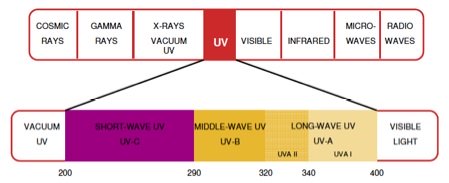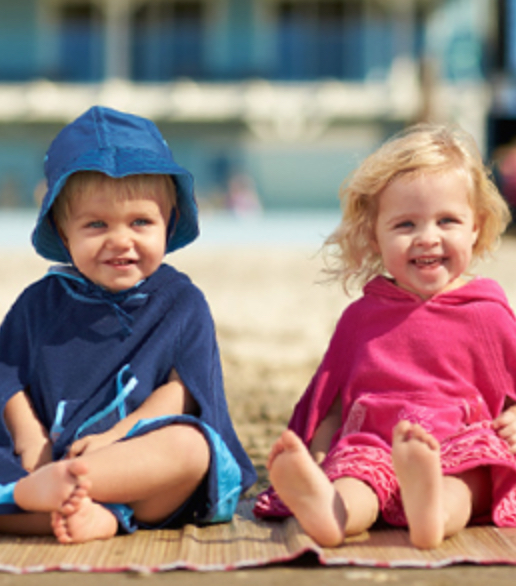UV protection clothing
UV protection clothing and sunscreen are the 2 main ways to provide protection from the suns' UV rays.
Overexposure to UVA and UVB rays can result in sunburnt skin, accelerated skin aging and even skin cancer.
 The UV spectrum showing UVA and UVB rays
The UV spectrum showing UVA and UVB raysUV protection clothing for additional protection
Added sun protection in your clothing allows an increase in sun protection for the whole family relatively easily.
It makes practicing good sun care habits for adults and children a whole lot more effective too.
The great thing is that there are a number of ways to practice good sun care. Keeping your skin safe from ultraviolet rays isn't just limited to using sunscreen, it can include what you wear as well.
Clothing with an Ultra Violet Protection Factor (UPF) is an additional form of sun care that is growing in popularity.
People all over the world love to be outdoors when the sun is out, absorbing its energy, participating in family outdoor activities, sports events, swimming, biking, hiking and camping, or just a good old leisurely walk.
Some people find applying sunscreen to be a chore and many more forget to apply any in the first place. But with UV protection clothing, staying safe from UV rays is as simple as choosing what to wear today.
UV protection clothing rating system
UPF (Ultraviolet Protection Factor) is a rating system used for apparel that is similar in concept to the SPF (Sun Protection factor) used for UVB protection in sunscreens. It represents the ratio of sunburn-causing UV without and with the protection of the fabric.
In 1996, the term UPF was devised in Australia as a measure of how much UV penetrates a fabric. Today, it indicates how effectively fabrics shield skin from the ultraviolet (UV) rays.
UPF is determined by using a UV transmittance analyzer to gauge the spectral transmission of UVB and UVA through a fabric.
If a fabric is rated UPF 30, then it is absorbing or blocking 29 out of 30 units of UVR, or 97 percent of UVR.
To achieve a UPF, a fabric must undergo 40 simulated launderings, be exposed to the equivalent of 2 years of light exposure and be tested with chlorinated and/or salted water if it is intended for swimsuits.
The higher the UPF number, the greater the degree of UV protection a garment offers, where 50 is the maximum.
Unlike SPF though, UPF gauges a fabric's effectiveness against both ultraviolet A (UVA) and ultraviolet B (UVB) light.
An SPF number pertains only to a sunscreen's effectiveness against UVB rays, the sunburn-causing segment of the ultraviolet spectrum. Some sunscreens include ingredients that shield skin from UVA rays as well as UVB, but many disagree on how well the UVA protection can be measured.
UV protection in ordinary clothing?
 Ordinary clothing for UV protection?
Ordinary clothing for UV protection?Ordinarily, wearing long pants, hats, and long-sleeved shirts are good for UV protection, but in order to get the best results, you'll want to invest in items that are actually designed to protect more efficiently for both UVA and UVB rays.
Regular clothing found in your closet can offer some protection over nothing, but not much.
UV protection clothing, on the other hand, is made of material that is both tightly knitted and breathes well. Any fabric will disrupt UV radiation to some degree, but clothing that with an Ultraviolet Protection Factor (UPF) value protects far better. UPF ratings range from 15 (good) to 50+ (excellent).
Normal clothing will provide UPF on average below 10.
UPF protected clothes have special weaves, and are treated with UV-absorbing chemicals such as titanium dioxide. Each article of UV protection clothing is labeled with a specific UPF rating. This rating appears as a number on the clothing label and states how much protection it provides. A majority of this type of clothing can completely block as much as 97% of UV rays.
However, it is important to know that any part of your skin that is exposed should be covered with a sunscreen.
Some people have skins with a far greater need for UPF-rated clothing. Eg Fair-skinned or sun-sensitive people, or young children. Some need more than sunscreen protection due to:
- extended time spent outdoors
- being at high altitudes
- on UV reflective surfaces like snow or ice or water
While relatively expensive, this type of clothing is usually very high quality and guaranteed to keep you protected from UV rays no matter where you are or what the weather is like.
To be deemed sun-protective, such clothing must have a UPF of more than 30 and retain its sun-protective qualities after numerous washings and exposure to sunlight.






New! Comments
Have your say... please leave me a comment in the box below.